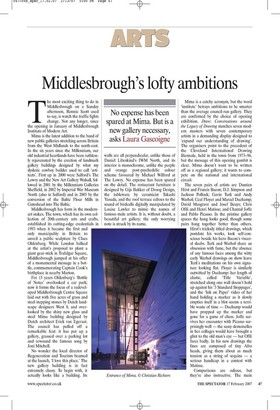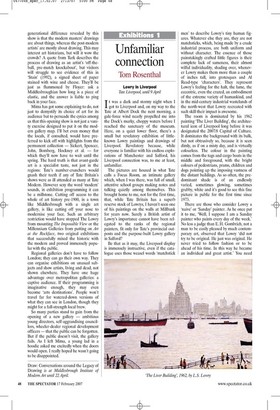Middlesbrough's lofty ambitions
No expense has been spared at Mima. But is a new gallery necessary, asks Laura Gascoigne The most exciting thing to do in Middlesbrough on a Sunday afternoon, Ronnie Scott used to say, is watch the traffic lights change. Not any longer, since the opening in January of Middlesbrough Institute of Modern Art.
Mima is the latest addition to the band of new public galleries stretching across Britain from the West Midlands to the north-east. In the six years since the Millennium, our old industrial heartlands have been ruthlessly rejuvenated by the erection of landmark gallery buildings designed by what my dyslexic cowboy builder used to call 'artitects'. First up in 2000 were Salford's The Lowry and the New Art Gallery Walsall, followed in 2001 by the Millennium Galleries Sheffield, in 2002 by Imperial War Museum North (also in Salford) and in 2003 by the conversion of the Baltic Flour Mills in Gateshead into The Baltic.
Middlesbrough has form in the modernart stakes. The town, which has its own collection of 20th-century arts and crafts, established its cutting-edge credentials in 1993 when it became the first and only municipality in Britain to unveil a public sculpture by Claes Oldenburg. While London balked at the artist's proposal to plant a giant gear-stick in Trafalgar Square, Middlesbrough jumped at his offer of a monumental message in a bottle, commemorating Captain Cook's birthplace in nearby Marton.
For 15 years Oldenburg's 'Bottle of Notes' overlooked a car park; now it forms the focus of a redeveloped Middlesbrough Centre Square laid out with five acres of grass and steel stepping stones by Dutch landscape designers West 8, and overlooked by the shiny new glass and steel Mima building designed by Dutch architect Erick van Egeraat. The council has pulled off a remarkable feat: it has put up a gallery, grassed over a parking lot and rewound the famous song by Joni Mitchell.
No wonder the local director of Regeneration and Tourism beamed at the launch, 'I love this place.' The new gallery building is in fact extremely classy. To begin with, it actually looks like a building. Its walls are all perpendicular, unlike those of Daniel Libeskind's IWM North, and its interior is monochrome, unlike the purple and orange post-psychedelic colour scheme favoured by Michael Wilford at The Lowry. No expense has been spared on the detail. The restaurant furniture is designed by Gijs Bakker of Droog Design, the tableware by ceramicist Takashi Yasuda, and the roof terrace echoes to the sound of birdcalls digitally manipulated by Louise Lawler to mimic the names of famous male artists. It is, without doubt, a beautiful art gallery; the only worrying note is struck by its name.
Mima is a catchy acronym, but the word 'institute' betrays ambitions to be smarter than the average council-run gallery. They are confirmed by the choice of opening exhibition. Draw: Conversations around the Legacy of Drawing matches seven modern masters with seven contemporary artists in a demanding display designed to 'expand our understanding of drawing'. The organisers point to the precedent of the Cleveland International Drawing Biennale, held in the town from 1973-96, but the message of this opening gambit is clear. Mima doesn't want to be written off as a regional gallery; it wants to compete on the national and international circuit.
The seven pairs of artists are Damien Hirst and Francis Bacon; D.J. Simpson and Jackson Pollock; Gavin Turk and Andy Warhol; Ceal Floyer and Marcel Duchamp; David Musgrave and Josef Beuys; Chris Ofili and Henri Matisse; and Chantal Joffe and Pablo Picasso. In the pristine gallery spaces the hang looks good, though some pairs hang together better than others. Hirst's tricksily titled drawings, which postdate his works, look self-conscious beside his hero Bacon's visceral daubs. Turk and Warhol share an obsession with fame, but the absence of any famous faces among the witty early Warhol drawings on show leave Turk's meditations on his own signature looking flat. Floyer is similarly outwitted by Duchamp: her length of elastic, called 'Title Variable', stretched along one wall doesn't hold up against his '3 Standard Stoppages', and the 'Ink on Paper' video of her hand holding a marker as it slowly empties itself in a blot seems a terrible waste of time — Duchamp would have propped up the marker and gone for a game of chess. Joffe survives her encounter with Picasso surprisingly well — the sassy demoiselles in her collages would have brought a glint to the old man's eye — but Ofili fares badly. In his new drawings the lines are composed of tiny Afro heads, giving them about as much tension as a string of sequins — a serious handicap in a contest with Matisse.
Comparisons are odious, but they're also instructive. The main generational difference revealed by this show is that the modern masters' drawings are about things, whereas the post-modern artists' are mostly about drawing. This may interest art historians, but will it wow the crowds? A quote from Turk describes the process of drawing as an artist's `off-theball, pre-match knockabout', but visitors will struggle to see evidence of this in 'Stain' (1992), a signed sheet of paper stained with wine and cheese. They'll be just as flummoxed by Floyer: ask a Middlesbroughian how long is a piece of elastic, and the answer is liable to ping back in your face.
Mima has got some explaining to do, not just to demystify its choice of art for its audience but to persuade the cynics among us that this opening show is not just a vanity exercise designed to put it on the modern gallery map. I'll bet even money that the locals, if consulted, would have preferred to kick off with highlights from the permanent collection — Sickert, Spencer, John, Bomberg, Hockney et al. — for which they'll now have to wait until the spring. The hard truth is that avant-garde art is a specialist taste, not just in the regions: Tate's number-crunchers would gnash their teeth if any of Tate Britain's shows were as ill attended as many at Tate Modern. However sexy the word 'modern' sounds, in exhibition programming it can be a millstone. Cutting off access to the whole of art history pre-1900, in a town like Middlesbrough with a single art gallery, is like cutting off your nose to modernise your face. Such an arbitrary restriction would have stopped The Lowry from mounting The Impossible View or the Millennium Galleries from putting on Art at the Rockface, two original exhibitions that successfully mixed the historic with the modern and proved immensely popular with the public.
Regional galleries don't have to follow London; they can go their own way. They can organise exhibitions on unusual subjects and show artists, living and dead, not shown elsewhere. They have one huge advantage over metropolitan galleries: a captive audience. If their programming is imaginative enough, they may even become 'arts destinations'. People won't travel far for watered-down versions of what they can see in London, though they might for a full-strength local brew.
So many parties stand to gain from the opening of a new gallery — ambitious young directors, self-aggrandising councillors, wheeler-dealer regional development officers — that the public can be forgotten. But if the public doesn't visit, the gallery fails. As I left Mima, a young lad in a hoodie asked me excitedly when the doors would open. I really hoped he wasn't going to be disappointed.
Draw: Conversations around the Legacy of Drawing is at Middlesbrough Institute of Modern Art until 22 April.


























































 Previous page
Previous page